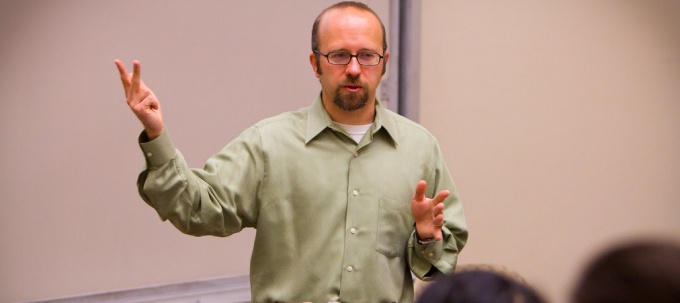
Bringing brain science to IP law
For too long, argues Professor Mark Bartholomew, judicial decisions in intellectual property cases have been unpredictable and varied, dependent on a judge’s perception of whether a brand, artistic work, or commercial design appears too similar to another. Copyright, patent, and trademark cases, he says, have been muddied by the mysteries of the creative process and how audiences perceive its products.
In his new book, Intellectual Property and the Brain (Cambridge University Press), Bartholomew points to a more rigorous approach: using the tools of neuroscience to define the terms of the legal tests that apply in IP disputes.
Scholars and practitioners have applied advances in neuroscience—the study of the brain and nervous system—to the criminal justice system, but Bartholomew’s book is the first to bring the insights of brain scans and MRI imaging to intellectual property law. “Recent advances in the measurement of human thought promise a dose of clarity for the uncertainty that has paralyzed the law of intellectual property for decades,” he writes. “My aim is to offer a template for marrying the science with the law in a way that stays true to [the discipline’s normative] principles.”

Mark Bartholomew
A conversation with Professor Bartholomew reflects the depth of thinking he has brought to a fascinating subject.
Law school is all about thinking like a lawyer, but in this book you’re thinking like a neuroscientist. What led you to investigate the connection between brain function and law, and specifically IP law?
I’ve always been fascinated by psychology. And psychology naturally connects with law, as vast swaths of legal doctrine are concerned with the mindsets of particular actors—what did they know, were they reckless, did they intend the consequences of their actions? Neuroscience really cannot (yet) shed much light on these sorts of individual mental states. MRI analysis cannot tell us whether a witness is lying or a particular criminal defendant acted with guilty intent. Intellectual property, however, concerns itself not so much with individual mental states but with the aggregate sentiments of particular groups of people like artists and audiences. This makes copyright, patent, and trademark law better suited than other legal subject areas to immediately implement some of the latest findings in neuroscientific research.
Your book is full of examples of how this connection plays out in practice. Is there one that you found to be especially evocative or surprising?
In one study, researchers scanned subjects’ brains as they viewed several well-known trademarks. According to the researchers, each brand has a unique neural signature with different brain regions reflecting perceptions like “excitement,” “ruggedness” or “sophistication.” By viewing these neural signatures, researchers could distinguish whether the subject was thinking about Apple or Microsoft, Coke or Pepsi. Trademark law has been hesitant to recognize claims of harm to brand reputation, at least absent evidence of consumer confusion. But with this kind of tangible proof of what brands actually mean to consumers, one could envision courts becoming more receptive to such claims.
You write about how neuroscience addresses the minds of both creators and their audiences. How might these tools speak to questions of copyright infringement? Is there a more reliable standard in science than in the way current IP law is administered?
Copyright law asks whether one work is “substantially similar” to another—that is the test for infringement. The problem is that the law assumes that aesthetic comparisons operate the same for all audiences and for all artistic works. Thanks to neuroaesthetics—the study of the neural processes underlying aesthetic behavior—we know this one-size-fits-all approach is mistaken. Audiences with different levels of experience with a particular artistic genre (e.g. abstract art) pay attention to different things. We perceive music very differently from the way we perceive visual art. A better infringement test would arm judges and juries with more specific information about the particular audience and category of artistic output at issue.
The use of neuroscience to understand behavior has the potential to change the balance of power in legal decision-making. Do you worry that lawyers outside of large, well-resourced firms will increasingly be at a competitive disadvantage?
I think this is a real concern. In fact, in some earlier research, I wrote about how psychologists began serving as experts in trademark cases in the early 1900s, and their findings tended to be biased in support of the already established brands that could afford their services. I worry that the introduction of neuroscientific expertise could be déjà vu all over again. Still, a lot of my suggestions for reform do not require the admission of expensive expert evidence. Instead, an accumulation of neuroscientific discoveries should convince courts, on their own initiative, to correct some of the outdated understandings about art and audiences still guiding intellectual property law.
What do you see as the implications, for IP law practitioners, of this field of study?
I would start out by cautioning that neuroscience is in no way a replacement for legal judgment. The technology is simply not at the point where we can scan the brains of authors and audiences to decide cases, and there are reasons why such evidence should not be determinative regardless of technological capability. But practitioners should be aware of what neuroscience is doing to alter longstanding beliefs about creativity, aesthetic appreciation, and consumer capabilities—all questions at the heart of intellectual property law. This knowledge can help them advocate for changes to help their clients while simultaneously pushing the law toward a more accurate assessment of human behavior.
